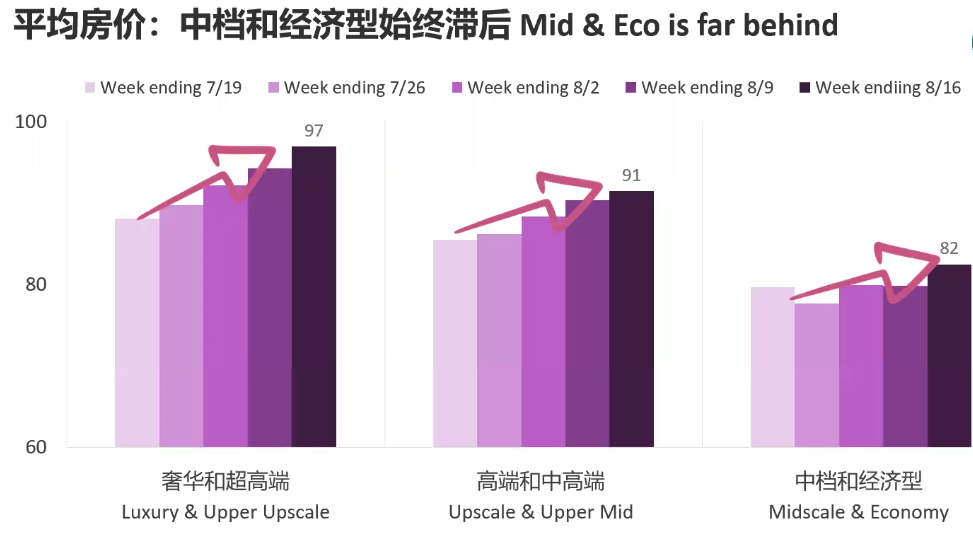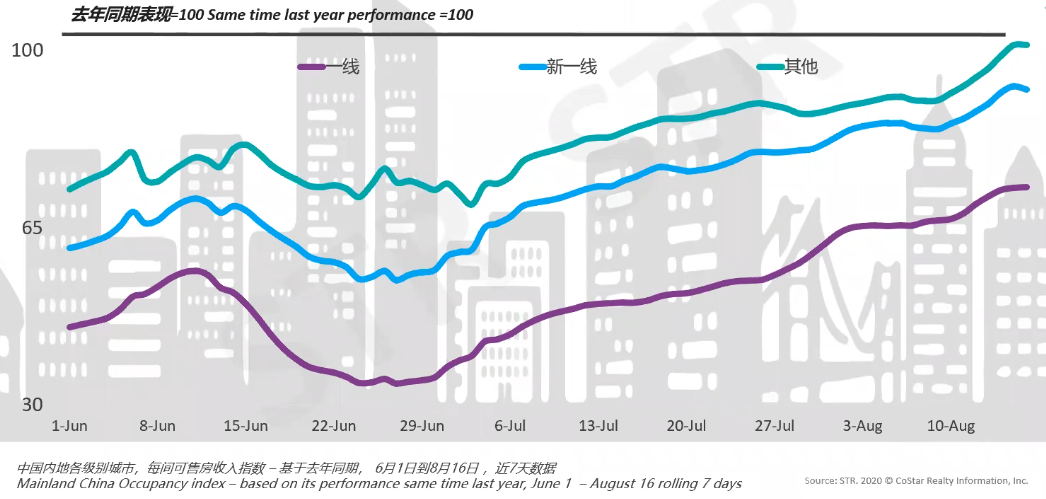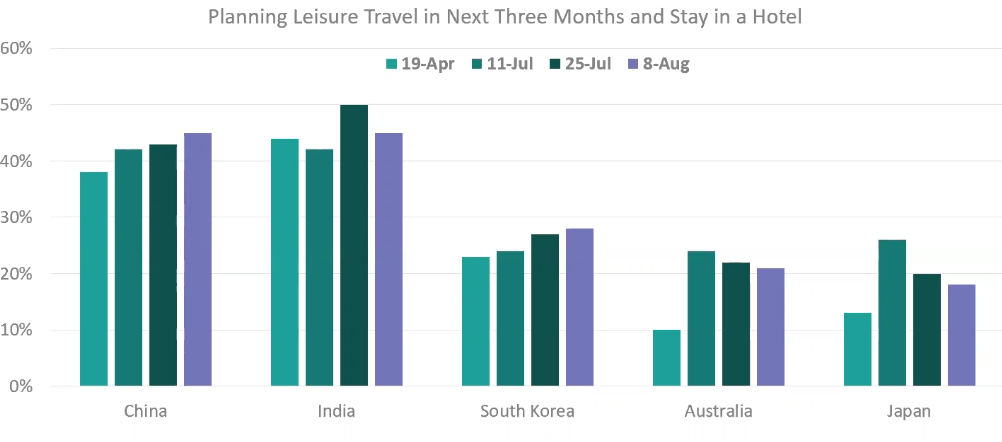The impacts of COVID-19 have been felt far and wide around the world and across industries. As one of the first hit but also one of the first economies to successfully slow the spread of the virus, China has already been seeing a gradual recovery from the impact of COVID-19.
The supply-demand dynamics of the hospitality industry in China thus present an interesting case study for what the road to recovery may look like for other economies around the world, as soon as the pandemic is contained. In a webinar with EHL, Christine Liu, Regional Manager for North Asia at STR and Yong Chen, Associate Professor of Tourism Economics at EHL, shared some data and insights on how the hospitality industry in China has reacted to the COVID-19 pandemic.
Note: This webinar was recorded on August 26, 2020. All data presented and opinions expressed were current as of this date.
What are the current hospitality trends in China now – Christine, would you mind sharing some statistics with us?
Christine: Looking at the recovery globally, we can see that the US had finally reached 50% occupancy in the week ending August 16, which is the latest data we have now [at the time of the webinar]. Europe had been picking up quickly since June and closed the gap with the US; while the Chinese hotels have recovered the most aggressively so far, reaching as high as 67% occupancy in the week ending August 16.
Focusing on the occupancy of Mainland China, we defined the recovery in three phases:
- Phase 1: From March 16; this is the very early stage where we saw some recovery, starting with a slight difference in weekday and weekend patterns.
- Phase 2: From May 1, the Labour Day holiday in China, demand had grown more strongly than March and April. We began to see some small conferences, government meetings, as well as the National Congress which was successfully completed before the end of May.
- Phase 3: As Corporate businesses started picking up more in June, the second wave of cases appeared in Beijing. But fortunately, by July 4, people could start travelling more freely again, and the university entrance exams were also completed [around that time] – and from there, every Saturday reached a new high in terms of occupancy – so we marked this as the third phase.
Performance by Class
By the week ending August 16, the occupancy index to 2019 levels was already over 90%, which was a very strong signal. In particular, the Luxury & Upper Upscale segments have been very strong. Usually, it is the Midscale & Economy hotels that drive the initial recovery at the very early stage, but this has not been the case – Luxury & Upper Upscale have really outperformed. Even in terms of rates, by the week ending August 16, these segments were already very, very close to last year’s figures, while the Upscale & Midscale hotels were a little weaker, and the Midscale & Economy hotels were trailing even further behind.
Consequently, when it comes to RevPAR (revenue per available room), the Luxury & Upper Upscale market had already reached 90% of last year figures, compared to 75% for the Midscale & Economy.
ADR Index Performance by Class. Screengrab from EHL Webinar. Source: STR

Performance by Geography
Looking at the different cities, they have also definitely performed differently. For the Tier 1 cities, they are more reliant on the MICE (meetings, incentives, conferencing, and exhibitions) and wedding business as well as international travelers – but because they have more supply and big conference [venues] and with borders still closed, we see that the initial pick up was more from the suburbs and resort hotels; places that you could drive rather than fly to more easily. Nonetheless, in China overall, I see a very positive recovery.
Professor Chen, what do you think the statistics mean to the local and global travelers, and is there any economics concept that you think can better explain these trends?
Prof Chen: I would like to focus on three aspects regarding the statistics:
- If we compare the general pattern of recovery across different regions: China, the US, and Europe, China has of course gradually recovered from the COVID-19 outbreak – and the reason is very straightforward – demand has increased and people have started to travel domestically since April.
- The second is about the different Hotel classes: We see a better recovery in occupancy and Average Daily Rate (ADR) in the luxury sector versus the midscale and economy sector, and I think there may be some substitution effects between the two. People who used to stay in lower end hotels may be replacing them with higher end hotels, so demand has been pushed up in the short run. This is one thing which is specific to this period – in luxury hotels, you have better service quality and likely more resources to maintain hygiene standards, which is a concern for consumers these days.
- Third is the different pace of recovery between the different tiers of cities: From the data, we see that the first-tier cities had been lagging behind other cities, and I think it’s because demand now is being driven by leisure rather than business travelers, especially as many companies are cutting non-essential business trips to save costs. As a result, we are seeing a greater demand for the second and even third tier cities in China [which are typically more driven by leisure demand].
Christine: To add on to Professor Yong’s comments on the performance of luxury hotels, I think this is also related to the pattern of travel now – the topic of consumption upgrades, which we have been talking about in the last few years, with the growing middle class and people having more money to travel. And I think another reason is that people normally travel overseas during this summer holiday period, and now by travelling domestically, even staying at luxury hotels would still be cheaper than going to other countries.
Since we’re talking about post-COVID recovery in the hospitality and tourism industry, could you maybe share with us more on how you would compare the hospitality and tourism industry in China before and after COVID?
Christine: Going back to recoveries during the summer holiday period, South China actually performed best – they were almost back to last year’s level between 6 July and 16 August. This was mainly driven by Shenzhen and Sanya, so the Greater Bay Area. Guangzhou’s performance was better than Beijing and Shanghai – but the other regions can be quite different. In the northeast, we know that Liaoning has had new cases, and in the north – Mongolia, Shanxi, Hubei, Beijing – they have been dragged down by the Greater Beijing area. Since July, Hubei has only been at 30% occupancy – that is the worst in the whole of China among the big cities. The east of China had also performed well, thanks to Shanghai, Hangzhou, Nanjing, and Suzhou – these places with a lot of leisure destinations and strong weekend business.
But to highlight the before and after, one shining star is Sanya – it is the number one destination in the world in terms of performance over this period – it’s the only market that has performed better than last year in June and July. In fact, July RevPAR had increased by 44% compared to last year. Since people can’t travel internationally, Sanya’s island ocean views have been very attractive for Chinese tourists – and the duty-free shops at Haitang Bay, along with the new local policies implemented to encourage duty-free shopping there have bolstered performance. Between July 1 to 27, in just four weeks’ time, the off-shore duty-free shop received 281,000 tourists – that’s a nearly 43% increase from last year, which led to a 234% increase in revenue to RMB 2.2 million. This shows that Chinese people are still willing to travel and spend, and that the buying power is still there.
Professor, what’s your feedback looking at this data? What factors do you think may impact the recovery and what does that mean for the Chinese economy?
I think one of the reasons for the differences in performance across the regions might be the seasonal demand – for example, some people travel to the islands in southern China, because it’s a destination which is more appealing in the summer. Now in the winter, you may go to northern China to Jilin or Dongbei for example, [and so maybe we will start to see performance picking up there]. Another reason is that business travel does not have a strong demand seasonality; demand now is still primarily driven by leisure purposes – and leisure travelers clearly don’t have to go to big cities, especially if they want to maintain distance from other people.

Occupancy Index – Tier 1 Cities (Purple) Falling Behind. Screengrab from EHL Webinar. Source: STR
And speaking again about Christine’s point on better performance in luxury hotels because people are travelling domestically, if there’s no COVID-19 pandemic, people may go to Thailand, Florida, or the Mediterranean – now, there’s only one option in Mainland China which is Sanya – that’s why it’s been performing so well. But I am concerned whether this growth can be sustained in the long term. Because if you want to attract travelers in the long term and not just the short term, you have to improve a lot in service quality and build a service culture – which takes years to build. And it is only when you achieve that, can you both attract and retain travelers in the long run – and from my observations, I think there’s still a long way to go for Sanya to become an international tourism destination.
My last point is on Wuhan. Nobody [outside China] really knew Wuhan before February – but now, Wuhan has become very well-known across the world, although maybe not for the best reasons. But this could be an opportunity for the local industry or government to position Wuhan as an attractive destination in China as well as internationally. Wuhan has many cultural and natural resources, so it’s really capable of attracting international travelers – it may just take some time for the supply to keep up with the expectations of travelers.
What aspect of the Chinese hospitality and tourism industry do you think will fundamentally change after COVID-19, and what do you think is the biggest challenge for the industry?
Christine: COVID-19 has provided us the best opportunity to rethink about our hospitality industry – how we should structure our supply to match the demand, or how to create demand based on what we have. Hotels which were built 5, 10 years ago might not be the product for the new generations or new class of people who want to have a unique experience [so they especially need to think of ways to reinvent themselves]. This has to be a long-term considerations for developers, managers, and operators. And we also need to consider what it will mean for destinations [like Sanya] when the borders reopen, and people can begin travelling again to the Maldives and other international destinations.
Prof Chen: It’s a really difficult question to answer. As far as my personal experience is concerned, I feel a little uncertain about the future. Before COVID, what I believed was that the world will become much better and better over time. But with COVID, every country, every person is being affected – so when we’re making our consumer decisions, I think these decisions will not only be affected by our income or financial means, but also by how we see the world around us; how we want to plan our future. I think this is something that is deeply rooted in people’s decision making – and accordingly, the industry has to respond to people’s perceptions and expectations of the future. The principle is very simple, but I think it’s very effective and useful.
Christine, could you share with us STR’s forecast and how you see the timeline of recovery for the hospitality industry?
Christine: To look at the future, we will need to look at how supply has changed. China is still a major market for the international chains, so when we compare the pipeline projects as of January versus now, there were 413 projects to be opened in 2020 – now as of July, although 14% of this has already opened, 35% have been postponed to 2021 or 2022, and 12% have been abandoned or deferred. With this 35% postponed over the next two years, it will give other hotels some room to operate existing hotels better. In the last few months, 269 new projects have also been proposed, which signals that owners still have the interest to invest in hotels, and chain hotels still have a strong willingness to operate those hotels.
Based on our latest forecast reports, we expect the occupancy of the Tier 1 markets to be back in 2023, and ADR a little later in 2024. In most of the 2nd tier markets, we expect ADR to be back in 2024 but demand comes back ealier. We should also consider that there are a lot of hotels to be opened over the next few years across many of these cities – with different chain scales, management companies, and a mix of international and also domestic chains. Nonetheless, Deloitte’s sentiment survey on people’s willingness to travel has shown that the markets in general have a relatively positive outlook, especially China.

Deloitte Consumer Behaviour Trends Tracker. Screengrab from EHL webinar. Source: Deloitte
What will be your advice to local business owners or business decision makers?
Prof Chen: There is no solution that fits every specific situation, but I am going to focus on service, because I still believe that whether we have this pandemic or not, the service, as far as tourism is concerned, is really the heart of our industry. And service is not something that we can build up in a few days or weeks – it’s impossible. Service is a culture. It is the linkage between all service providers, including hotels, restaurants, and the guests. In the long term [beyond this pandemic], the best solution is to build a connection between the service providers and the guests – it takes years or even decades to build up, but that is really strategically important for any business that is serving consumers and tourists. I think this is a principle that will not change even in the future.
Christine: Yes, I completely agree that service and people make a difference. Now, with so many hotels and brands, it’s easy to replicate the hardware and the design – but very difficult to replicate the service and power of a brand. One of our biggest challenges in this industry is talent, so I really hope to see EHL and other educational institutions and organizations bring more talent to the industry. Owners and management companies have already started to focus on people development, so this is a challenge not only now, but from the past and even for the future – and so that’s one of my big interests – to keep the young people loving the industry, to stay in the industry, and to be committed and to contribute.





